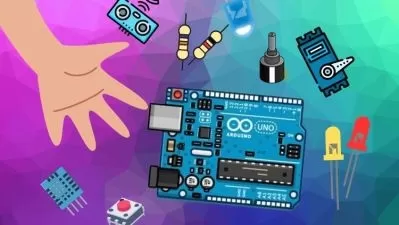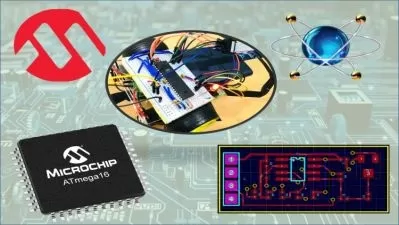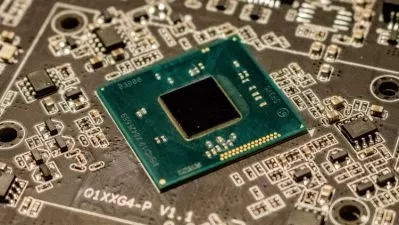Autodesk Eagle : PCB & Hardware Design for Beginners
Piyush Charpe
21:26:17
Description
Arduino compatible Electronics Circuit Design & Eagle PCB Design course using Atmega328p Microcontroller for Beginners
What You'll Learn?
- Practical aspects of electronics components - Resistor, Capacitor, Potentiometer
- How to use Autodesk Eagle software
- Hardware Design, Circuit Design, Schematic Design, PCB Design
- PCB ordering process
- Components ordering process
- Bill Of Material, Gerber Data generation
- Hardware Testing & Troubleshooting / Board Bring Up
Who is this for?
More details
DescriptionTraining Overview
Learn how to design PCB from scratch.
Covers the end-to-end hardware development process, with a step by step approach.
Uses Eagle software for PCB designing & Arduino IDE for programming the hardware.
Descriptions
This training will arm you with knowledge required to design your own PCBs from scratch. Every single step along the way has been thoroughly covered.
We will be building a custom Arduino UNO board from scratch, which can be programmed using the Arduino IDE. The training also covers some essential circuits (viz RGB LED, switches, preset, motor drivers, seven segment displays), and their interfacing with the microcontroller on the custom Arduino that we are building. You will find yourself using these circuits in a lot of future projects/products.
All in all, this training covers the end-to-end hardware development process. After completing the training, you will be confident in designing your own hardware.
Key Skills you will learn
Circuit Design
PCB Design
Hardware testing
Troubleshooting hardware issues
Who is this training for
Beginners, hobbyists & students getting started in embedded designing.
People building hardware for their engineering project.
People collecting knowledge to grab an internship or job in the embedded field.
You have any of the following questions:
a. How to convert an idea to a finished PCB?
b. What is the workflow for designing hardware?
c. How to approach schematic & layout designing?
d. How to read the components datasheet?
e. Where to order the PCB?
f. Where to get the components?
g. How are components soldered?
h. How to test & troubleshoot the circuit?
What will you learn
PCB Designing using eagle software
Atmega328P Microcontroller based system design (microcontroller used in Arduino Uno)
Power supply system design
Circuit design for LED, RGB LED, Switch, Preset, Motor Driver, Seven segment Display.
Purpose of every single component used & how to select them.
How to read components datasheet
PCB ordering process
Components sourcing
Components soldering
Hardware Testing & troubleshoot techniques
Why should you take this training
High industry demand : PCB design is one of the key skills required to work as a hardware design engineer in electronics product companies like Qualcomm, Texas Instruments, Microchip etc.
It's everywhere in your life : Whether it's smart watches, smart phones, IOT devices or electric vehicles, PCBs are everywhere. If designing a system based on a microcontroller & microprocessor excites you, then PCB design is for you.
High scope : The total installed base of IOT devices worldwide is projected to be around 30 billion units by 2025. Due to the surge in products being developed, the demand for PCB design engineers is increasing day by day.
Who this course is for:
- Beginner, Hobbyist & Professionals who want to learn hardware design & PCB Design
- Those who want to get started with hardware design process from scratch
- Those who are good in software and want to understand hardware
Training Overview
Learn how to design PCB from scratch.
Covers the end-to-end hardware development process, with a step by step approach.
Uses Eagle software for PCB designing & Arduino IDE for programming the hardware.
Descriptions
This training will arm you with knowledge required to design your own PCBs from scratch. Every single step along the way has been thoroughly covered.
We will be building a custom Arduino UNO board from scratch, which can be programmed using the Arduino IDE. The training also covers some essential circuits (viz RGB LED, switches, preset, motor drivers, seven segment displays), and their interfacing with the microcontroller on the custom Arduino that we are building. You will find yourself using these circuits in a lot of future projects/products.
All in all, this training covers the end-to-end hardware development process. After completing the training, you will be confident in designing your own hardware.
Key Skills you will learn
Circuit Design
PCB Design
Hardware testing
Troubleshooting hardware issues
Who is this training for
Beginners, hobbyists & students getting started in embedded designing.
People building hardware for their engineering project.
People collecting knowledge to grab an internship or job in the embedded field.
You have any of the following questions:
a. How to convert an idea to a finished PCB?
b. What is the workflow for designing hardware?
c. How to approach schematic & layout designing?
d. How to read the components datasheet?
e. Where to order the PCB?
f. Where to get the components?
g. How are components soldered?
h. How to test & troubleshoot the circuit?
What will you learn
PCB Designing using eagle software
Atmega328P Microcontroller based system design (microcontroller used in Arduino Uno)
Power supply system design
Circuit design for LED, RGB LED, Switch, Preset, Motor Driver, Seven segment Display.
Purpose of every single component used & how to select them.
How to read components datasheet
PCB ordering process
Components sourcing
Components soldering
Hardware Testing & troubleshoot techniques
Why should you take this training
High industry demand : PCB design is one of the key skills required to work as a hardware design engineer in electronics product companies like Qualcomm, Texas Instruments, Microchip etc.
It's everywhere in your life : Whether it's smart watches, smart phones, IOT devices or electric vehicles, PCBs are everywhere. If designing a system based on a microcontroller & microprocessor excites you, then PCB design is for you.
High scope : The total installed base of IOT devices worldwide is projected to be around 30 billion units by 2025. Due to the surge in products being developed, the demand for PCB design engineers is increasing day by day.
Who this course is for:
- Beginner, Hobbyist & Professionals who want to learn hardware design & PCB Design
- Those who want to get started with hardware design process from scratch
- Those who are good in software and want to understand hardware
User Reviews
Rating
Piyush Charpe
Instructor's Courses
Udemy
View courses Udemy- language english
- Training sessions 116
- duration 21:26:17
- Release Date 2023/03/29
















